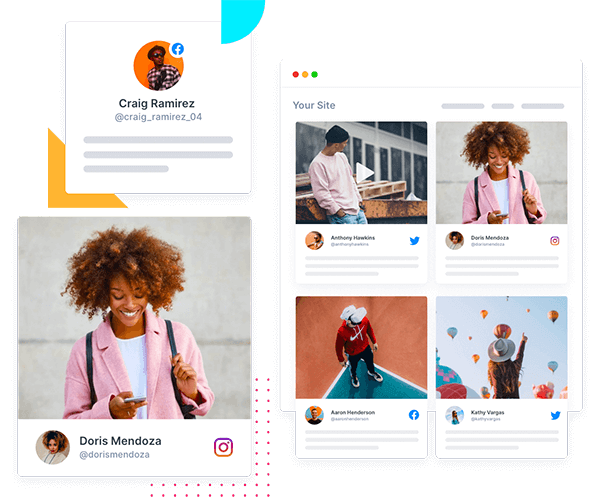Future of Social Media Aggregation: Trends & Innovations to Watch Out For
In today’s interconnected digital landscape, social media plays a significant role in how we communicate, connect, and consume information. But with the vast array of platforms and content available, keeping up with everything can be overwhelming.
That’s where social media aggregation steps in to simplify and streamline our online experiences. It gathers content from various social media platforms, consolidates it into one place, and presents it cohesively. This innovative approach allows users to stay up-to-date with their favorite social media channels and discover new content effortlessly.
In this blog post, we will explore the future of social media aggregation, delving into the trends and innovations set to revolutionize how we interact with social media. Whether you are a casual user, a social media enthusiast, or a business looking to optimize your online presence, understanding these developments will be crucial for staying ahead of the curve.
What is the Current State of Social Media Aggregation?
A social media aggregation tool is like having a personal assistant for your social media life. It’s all about bringing together the best of different social media platforms and presenting them to you conveniently and organized. Instead of hopping from one platform to another, you can access everything in a single location, saving you time and effort.
Here’s where today’s social media aggregation is…
Popular Social Media Aggregation Platforms & Tools:
Tagembed –
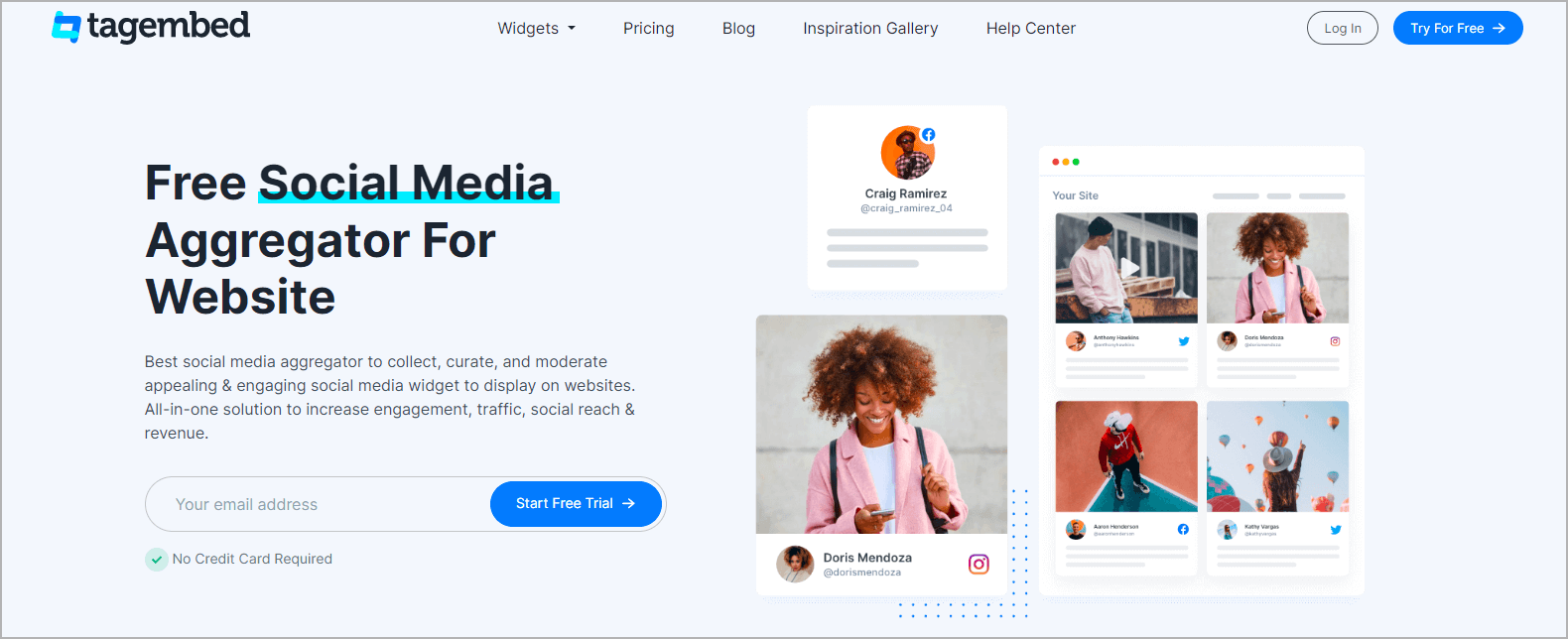
Tagembed is a handy tool that simplifies social media aggregation. It lets you gather content from different social media platforms and displays them all in one convenient feed. With Tagembed, you can effortlessly collect posts, images, and videos from platforms like Instagram, Twitter, and Facebook, and embed them on your website or blog. It’s a user-friendly platform that offers customization options, allowing you to choose how your aggregated content appears. You can even moderate the content to ensure it fits your brand image. With real-time updates and analytics, Tagembed helps you engage your audience and enhance your online presence by showcasing curated social media content in a seamless way.
Flipboard –
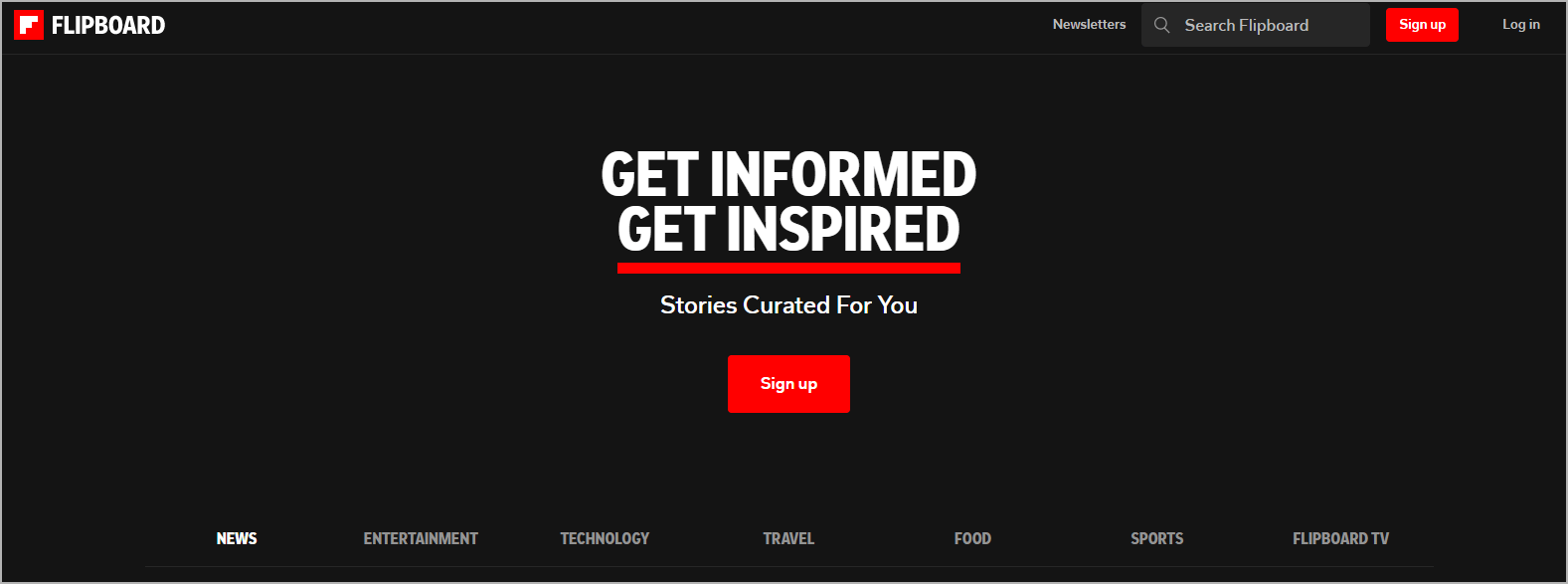
Think of Flipboard as your personalized digital magazine. It collects articles, blog posts, and social media updates based on your interests and transforms them into a visually appealing magazine-like format. You can dive into topics you love, discover new content, and even share your own curated magazines with others.
Feedly –
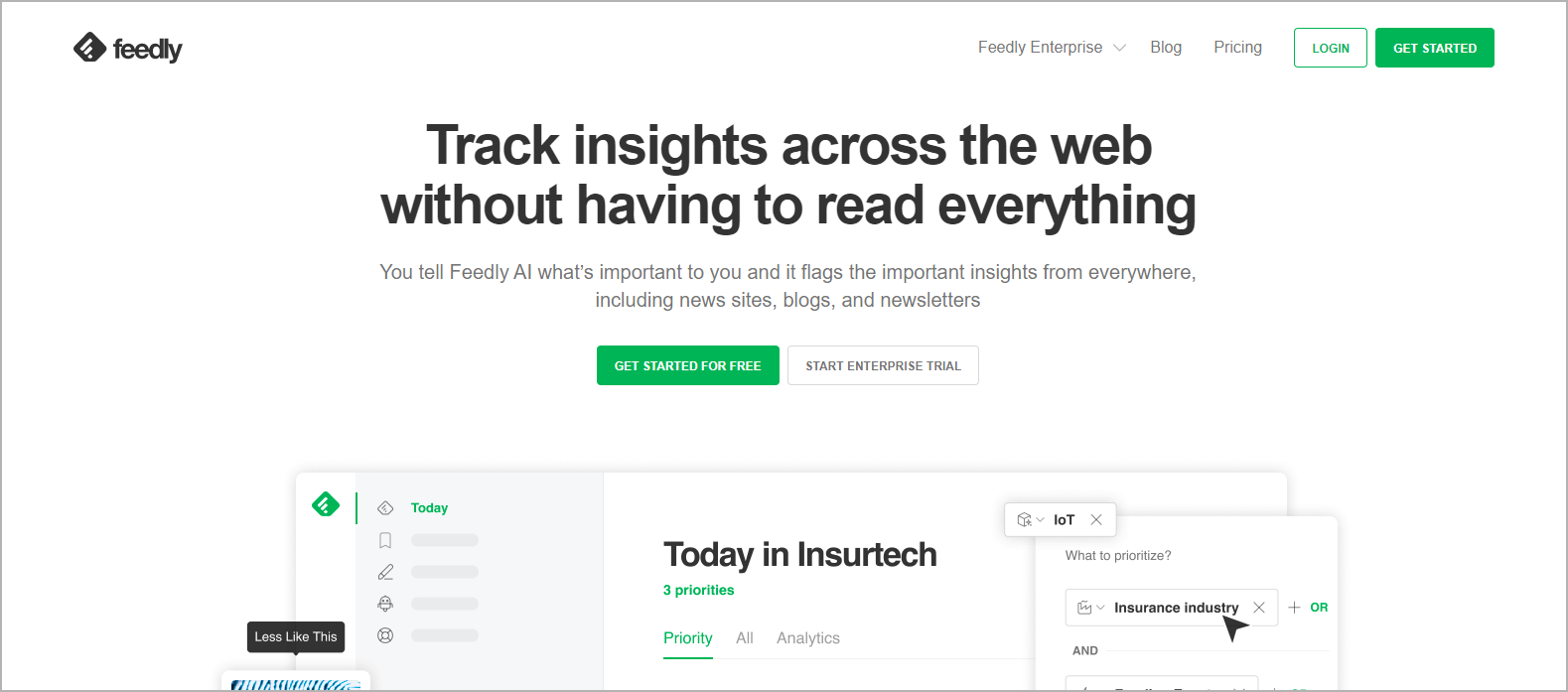
If you’re someone who loves staying on top of the latest news and trends, Feedly is your go-to platform. It allows you to subscribe to your favorite websites, blogs, and social media accounts. By consolidating all the updates in one place, you can browse through fresh content, customize your reading experience, and become an information powerhouse.
Hootsuite –
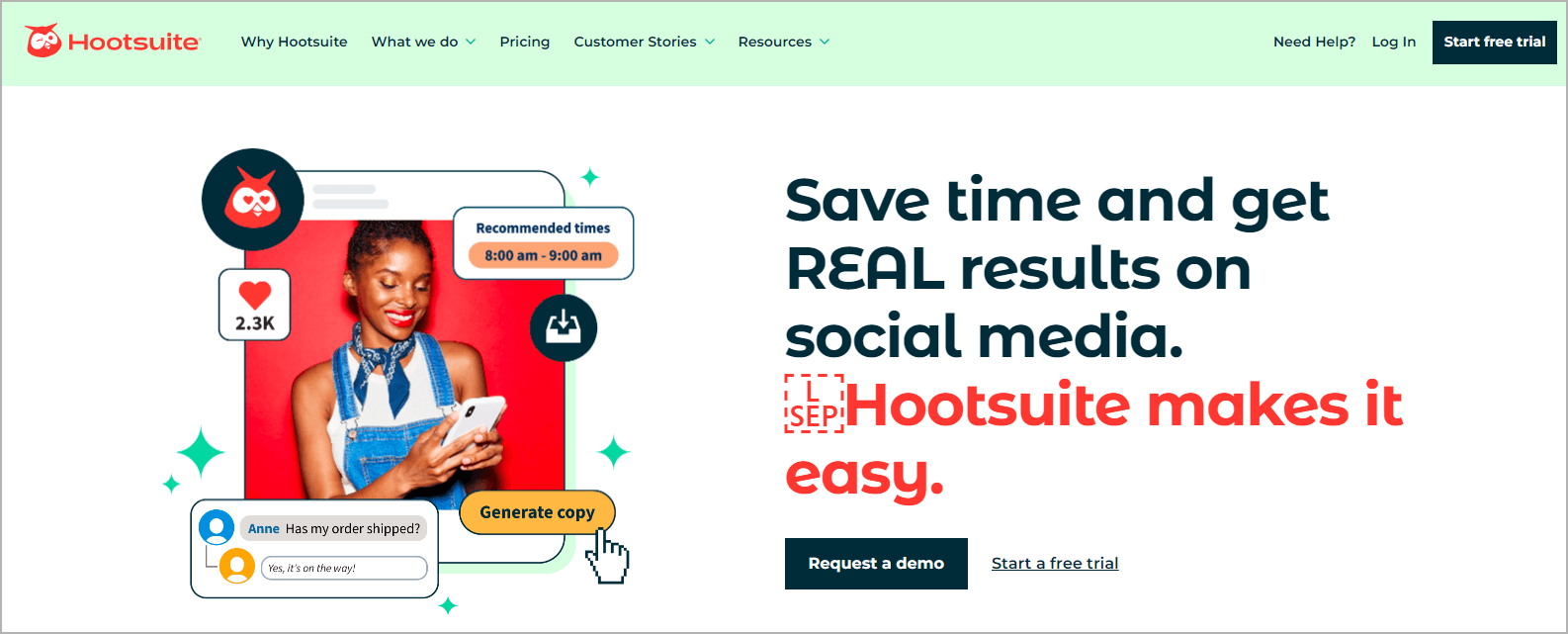
Hootsuite is a popular tool known for its social media management capabilities, but it also offers social media aggregation features. It brings together your different social media accounts, enabling you to monitor and engage with your audience seamlessly. You can schedule posts, track analytics, and even curate content from various platforms, making social media management a breeze.
Benefits and Limitations Today
Now, let’s talk about the advantages and limitations of social media aggregation.
Benefits –
Time-saving: With social media aggregation, you no longer need to switch between apps or tabs to check different platforms. Everything is conveniently organized in one place, allowing you to catch up on updates and engage with your favorite content more efficiently.
Personalization: Aggregation platforms empower you to personalize your social media experience. You can choose the topics, accounts, and hashtags you’re interested in, ensuring that you receive content that aligns with your preferences and passions.
Discoverability: Social media aggregation opens up a world of discovery. You can explore new accounts, articles, and trending topics outside your usual bubble, broadening your horizons and exposing you to fresh perspectives.
Limitations –
Content limitations: While social media aggregation brings content from different platforms together, it doesn’t cover every single platform or account. Some platforms may not be compatible with certain aggregation tools, so you might miss out on a few sources.
Interface differences: Each social media platform has its own unique interface and features. When aggregated, some aspects may not translate seamlessly, and you might miss out on the full functionality or experience provided by individual platforms.
Overwhelming volume: Social media aggregation can expose you to a vast amount of content, which can be overwhelming to navigate. It’s important to find the right balance and utilize customization features to filter and prioritize the content that matters most to you.
Alison Lancaster, CEO of Pressat says, “As social media aggregation continues to evolve, addressing these limitations and enhancing the overall user experience will be key focuses for platform developers.”
Now, let’s move on to explore the exciting trends and innovations that will shape the future of social media aggregation.
What are Some Current Trends in Social Media Aggregation?
To stay current in the dynamic world of social media, it’s important to understand the current trends in aggregation. Let’s examine the latest developments that are shaping the landscape of social media aggregation and influencing user behavior and experiences.
A. Artificial Intelligence and Machine Learning Advancements
“Artificial intelligence (AI) and machine learning (ML) are transforming the landscape of social media aggregation. With AI transforming social media aggregation, it’s crucial to understand the security side of these advancements. Handling AI in cybersecurity is vital for safeguarding data in this integrated, AI-driven landscape, ensuring that personalized user experiences do not come at the expense of privacy and protection.
These technologies enable platforms to analyze user behavior, preferences, and content to deliver highly personalized and relevant experiences. Artificial Intelligence powered algorithms can learn from your interactions, suggesting content that aligns with your interests and even predicting what you might enjoy next.”, says Sumeer Kaur, Founder of Lashkaraa.
For example, imagine a social media aggregator that learns your preferences over time and proactively curates content specifically tailored to your tastes. Whether it’s recommending articles, videos, or social media posts, AI-driven aggregation platforms can make your social media experience more engaging and personalized than ever before.
B. Personalization and Customization Features
“One-size-fits-all approaches no longer cut it in the world of social media aggregation. Users crave personalized experiences that align with their individual interests and preferences. That’s why platforms are placing a strong emphasis on personalization and customization features.”, shares Tom Miller, Director of Marketing at FitnessVolt. Social media aggregators now allow you to fine-tune your content selection by choosing specific topics, accounts, or hashtags to follow.
This way, you can curate your own feed and ensure that you’re exposed to the content that matters most to you. Moreover, some platforms offer advanced customization options, allowing you to organize and arrange content based on your preferred layout and design.
C. Integration with Emerging Technologies (e.g., AR, VR)
“Social media aggregation is not limited to textual content and images. The integration of emerging technologies like augmented reality (AR) and virtual reality (VR) is revolutionizing the way we consume and interact with social media.”, shares Max Whiteside, SEO and Content Lead, Breaking Muscle.
Imagine being able to immerse yourself in a virtual environment where you can view and interact with aggregated social media content in a 3D space. You could explore virtual rooms, each representing a different social media platform, and interact with posts and media as if they were tangible objects. This convergence of social media aggregation and emerging technologies has the potential to create unique and immersive experiences that will redefine how we engage with social media content.
D. Focus on Privacy and Data Security
“As social media aggregation becomes more prevalent, concerns around privacy and data security are growing. Users are becoming increasingly cautious about how their data is collected, stored, and shared. In response, social media aggregation platforms are placing a strong emphasis on privacy and data protection.”, shares Jeanette Johnson, Co-founder at Cool Chicken Breeds. To address these concerns, platforms are implementing robust security measures, such as AES encryption, to safeguard user data.
They are also giving users more control over their privacy settings and providing transparency about how data is collected and utilized. By prioritizing privacy and data security, social media aggregation platforms aim to build trust with their users and ensure that their information is handled responsibly.
What are Some Innovations Shaping the Future of Social Media Aggregation?
Looking ahead, several innovations are expected to shape the future of social media aggregation. Let’s delve into these exciting advancements and their potential impact on how we consume and interact with social media content.
A. Contextual Content Curation
“Contextual content curation is a game-changer in social media aggregation. Instead of relying solely on user preferences or popularity, platforms are incorporating contextual information to curate content.”, shares Benjamin Yost, Founder & CEO at Linkflow.ai. By understanding the broader context, such as the user’s location, current events, or trending topics, aggregation platforms can deliver content that is more relevant and timely.
For instance, imagine a social media aggregator that analyzes your location and presents you with local news, events, and updates from nearby businesses and communities. This contextual approach enhances the overall user experience by ensuring that the content you receive is aligned with your immediate surroundings and interests.
B. Real-Time Content Aggregation
“Real-time content aggregation is becoming increasingly important. Users want to stay updated with the latest news, trends, and conversations as they unfold. Social media aggregation platforms are integrating real-time capabilities, allowing users to access fresh and up-to-the-minute content from multiple sources.”, shares Paul Gordon, SEO Specialist at Paul Gordon SEO Agency. For example, imagine a social media aggregator that streams live updates, breaking news, and trending topics directly to your feed.
This real-time aggregation ensures that you’re always in the loop and enables you to participate in conversations as they happen, fostering a sense of immediacy and engagement.
C. Cross-Platform Integration and Seamless User Experience
“Gone are the days of siloed social media experiences. The future of social media aggregation lies in seamless cross-platform integration. Users no longer want to be limited to a single social media platform but instead desire a unified experience that brings together content from various platforms effortlessly.”, shares Mark Valderrama, owner of Aquarium Store Depot. Innovative aggregation platforms are striving to integrate multiple social media platforms into a single interface, allowing users to view and interact with content from different sources seamlessly.
This cross-platform integration not only saves time but also enables users to engage with their favorite accounts and content across multiple platforms without the need for constant switching.
D. Enhanced Analytics and Insights
“Data is at the core of social media aggregation, and platforms are leveraging enhanced analytics and insights to provide users with valuable information about their social media presence and audience engagement.”, shares Claire Walker, Chief Human Resources Officer at View Auckland. By analyzing aggregated data, platforms can offer detailed metrics, trends, and audience insights that help users optimize their social media strategies.
Imagine a social media aggregation platform that provides comprehensive analytics on content performance, audience demographics, and engagement metrics across multiple platforms. This level of insight allows users to understand their audience better, make data-driven decisions, and refine their social media content and strategies for maximum impact.
What is Its Impact on User Behavior and the Social Media Landscape?
The impact of social media aggregation on user behavior and the social media landscape is significant. Let’s explore how it influences content discovery, engagement, and the overall social media experience.
A. Influence on Content Discovery and Consumption Patterns
“Social media aggregators are reshaping how users discover and consume content. Whether their interest is in Universe or in pest cleaning and safety — with the ability to aggregate content from multiple platforms, users have a broader range of sources and perspectives at their fingertips. This expanded access to diverse content leads to more informed decision-making and a greater exposure to different ideas and viewpoints.”, shares Matthew Smith, SEO Expert at Invicta Environmental.
Furthermore, personalized and contextual content curation offered by aggregation platforms enhances the relevance and timeliness of content. Users can discover content tailored to their interests and preferences, resulting in a more engaging and satisfying content consumption experience.
B. Changes in User Engagement and Interaction
“Social media aggregation has the potential to transform how users engage and interact with content. By bringing together content from different platforms, aggregation platforms encourage cross-platform engagement and provide users with a centralized hub for social media interactions.”, shares Bruce Mohr, Vice-President at Fair Credit. For example, users can like, comment, and share posts from multiple platforms without having to navigate to each individual platform. This convenience promotes increased engagement and facilitates more meaningful interactions between users and content creators.
Moreover, real-time content aggregation enables users to participate in trending conversations and stay connected to the pulse of current events. This encourages active participation, fostering a sense of community and engagement among users.
What are Some Implications for Social Media Marketing Strategies?
The rise of social media aggregation has significant implications for social media marketing strategies. Brands and businesses need to adapt to this changing landscape to effectively reach and engage with their target audiences.
Firstly, marketers must focus on creating high-quality and compelling content that stands out in aggregated feeds. With content from various sources vying for attention, brands need to craft captivating posts that capture the interest of users amidst the content flood.
Secondly, personalized and contextually relevant content becomes essential for effective marketing. By understanding user preferences and leveraging aggregation platforms’ capabilities, marketers can deliver tailored messages that resonate with their audience.
Lastly, social aggregation platforms provide valuable analytics and insights to inform marketing strategies. Marketers can leverage aggregated data to understand audience behavior, optimize their content strategies, and make data-driven decisions to maximize their impact.
To Sum Up
The future of social media aggregators is set to bring exciting advancements and transformations. Current trends in social media aggregation, such as personalized content curation and cross-platform integration, are already reshaping how users discover and engage with content.
We can expect social media aggregators to continue evolving in key areas. Contextual content curation will deliver more relevant and timely information, while real-time aggregation will keep users connected to the latest trends. Cross-platform integration testing will offer seamless user experiences, and enhanced analytics will empower marketers with valuable insights.
The impact of social media aggregation on user behavior and the social media landscape is significant. Users will enjoy more personalized content experiences and actively participate in platform conversations. Marketers will need to adapt their strategies to leverage the potential of social media aggregation.
Johan Holmström, Head of Marketing at Mediatool predicts, “In the future, advancements such as AI, augmented reality, IoT integration, and increased focus on privacy and data security. These innovations will provide users with immersive experiences, greater data control, and improved convenience.
Embed social feed from Facebook, YouTube, Instagram, Twitter on your website, like a PRO
Invalid Email Address